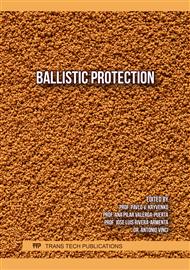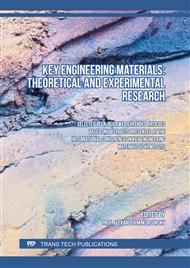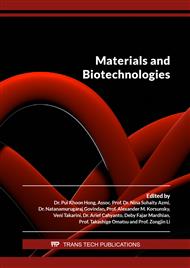[1]
N. Kiliç, B. Ekici, Ballistic resistance of high hardness armor steels against 7.62 mm armor piercing ammunition, Mater. Des. 44 (2013) 35–48.
DOI: 10.1016/j.matdes.2012.07.045
Google Scholar
[2]
P. Nyanor, A.S. Hamada, M.A. Hassan, Ballistic impact simulation of proposed bullet proof vest made of TWIP steel, water and polymer sandwich composite using Fe-SPH coupled technique, Key Eng. Mater. 786 (2018) 302–313.
DOI: 10.4028/www.scientific.net/kem.786.302
Google Scholar
[3]
N. Nsiampa, F. Coghe, G. Dyckmans, Numerical investigation of the bodywork effect (K-effect), (2009) 1561–1566.
DOI: 10.1051/dymat/2009220
Google Scholar
[4]
H. Kurtaran, M. Buyuk, A. Eskandarian, Ballistic impact simulation of GT model vehicle door using finite element method, Theor. Appl. Fract. Mech. 40 (2003) 113–121.
DOI: 10.1016/s0167-8442(03)00039-9
Google Scholar
[5]
A.M. Petrudi, K. Vahedi, M. Rahmani, M.M. Petrudi, Numerical and analytical simulation of ballistic projectile penetration due to high velocity impact on ceramic target, Frat. Ed Integrita Strutt. 14 (2020) 226–248.
DOI: 10.3221/igf-esis.54.17
Google Scholar
[6]
K. Krishnan, S. Sockalingam, S. Bansal, S.D. Rajan, Numerical simulation of ceramic composite armor subjected to ballistic impact, Compos. Part B Eng. 41 (2010) 583–593.
DOI: 10.1016/j.compositesb.2010.10.001
Google Scholar
[7]
S. Signetti, F. Bosia, S. Ryu, N.M. Pugno, A combined experimental/numerical study on the scaling of impact strength and toughness in composite laminates for ballistic applications, Compos. Part B Eng. 195 (2020) 108090.
DOI: 10.1016/j.compositesb.2020.108090
Google Scholar
[8]
Y. Yang, X. Chen, Investigation on energy absorption efficiency of each layer in ballistic armour panel for applications in hybrid design, Compos. Struct. 164 (2017) 1–9.
DOI: 10.1016/j.compstruct.2016.12.057
Google Scholar
[9]
P. V. Cavallaro, Soft Body Armor : An Overview of Materials , Manufacturing , Testing , and Ballistic Impact Dynamics Naval Undersea Warfare Center Division, NUWC-NPT Tech. Rep. 12. 12 (2011) 1–22.
DOI: 10.21236/ada549097
Google Scholar
[10]
M.J.N. Jacobs, J.L.J. Van Dingenen, Ballistic protection mechanisms in personal armour, J. Mater. Sci. 36 (2001) 3137–3142.
Google Scholar
[11]
S. Signetti, M. Nicotra, M. Colonna, N.M. Pugno, Modeling and simulation of the impact behavior of soft polymeric-foam-based back protectors for winter sports, J. Sci. Med. Sport. 22 (2019) S65–S70.
DOI: 10.1016/j.jsams.2018.10.007
Google Scholar
[12]
T. Børvik, S. Dey, A.H. Clausen, Perforation resistance of five different high-strength steel plates subjected to small-arms projectiles, Int. J. Impact Eng. 36 (2009) 948–964.
DOI: 10.1016/j.ijimpeng.2008.12.003
Google Scholar
[13]
R.P. Nair, C.L. Rao, Simulation of depth of penetration during ballistic impact on thick targets using a one-dimensional discrete element model, Sadhana - Acad. Proc. Eng. Sci. 37 (2012) 261–279.
DOI: 10.1007/s12046-012-0079-z
Google Scholar
[14]
B.A. Cheeseman, T.A. Bogetti, Ballistic impact into fabric and compliant composite laminates, Compos. Struct. 61 (2003) 161–173.
DOI: 10.1016/s0263-8223(03)00029-1
Google Scholar
[15]
M. ming Xu, G. yan Huang, S. shan Feng, X. yu Qin, G.J. McShane, W.J. Stronge, Perforation resistance of aluminum/polyethylene sandwich structure, Mater. Des. 100 (2016) 92–101.
DOI: 10.1016/j.matdes.2016.03.090
Google Scholar
[16]
I. Marom, S.R. Bodner, Projectile perforation of multi-layered beams, Int. J. Mech. Sci. 21 (1979) 489–504.
DOI: 10.1016/0020-7403(79)90011-0
Google Scholar
[17]
D.W. Zhou, W.J. Stronge, Ballistic limit for oblique impact of thin sandwich panels and spaced plates, Int. J. Impact Eng. 35 (2008) 1339–1354.
DOI: 10.1016/j.ijimpeng.2007.08.004
Google Scholar
[18]
E. Palta, H. Fang, D.C. Weggel, Finite element analysis of the Advanced Combat Helmet under various ballistic impacts, Int. J. Impact Eng. 112 (2018) 125–143.
DOI: 10.1016/j.ijimpeng.2017.10.010
Google Scholar
[19]
B. Gu, X. Ding, A refined quasi-microstructure model for finite element analysis of three-dimensional braided composites under ballistic penetration, J. Compos. Mater. 39 (2005) 685–710.
DOI: 10.1177/0021998305047264
Google Scholar
[20]
N. Kiliç, S. Bedir, A. Erdik, B. Ekici, A. Taşdemirci, M. Güden, Ballistic behavior of high hardness perforated armor plates against 7.62mm armor piercing projectile, Mater. Des. 63 (2014) 427–438.
DOI: 10.1016/j.matdes.2014.06.030
Google Scholar
[21]
C.Y. Ma, J.Y.R. Liew, Blast and ballistic resistance of ultra-high strength steel, Int. J. Prot. Struct. 4 (2013) 379–413.
Google Scholar
[22]
K. Krishnan, S. Sockalingam, S. Bansal, S.D. Rajan, Numerical simulation of ceramic composite armor subjected to ballistic impact, Compos. Part B Eng. 41 (2010) 583–593.
DOI: 10.1016/j.compositesb.2010.10.001
Google Scholar




